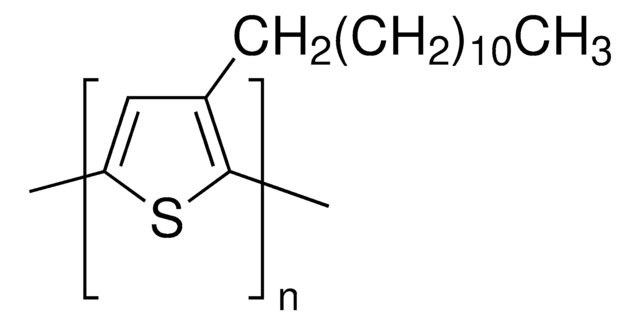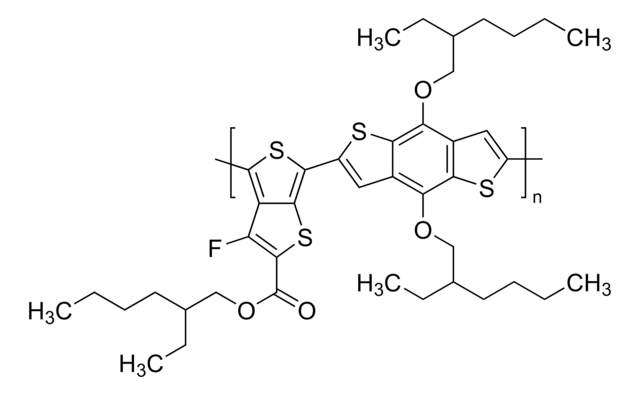445703
Poly(3-hexylthiophene-2,5-diyl)
regioregular
Synonim(y):
P3HT
About This Item
Polecane produkty
masa cząsteczkowa
average Mw 50,000-100,000
charakterystyka ekologicznej alternatywy
Design for Energy Efficiency
Learn more about the Principles of Green Chemistry.
sustainability
Greener Alternative Product
przewodność
~103 S/cm (when doped with iodine)
mp
238 °C
238 °C
fluorescencja
λex 443 nm; λem 568 nm in chloroform
Energia orbitalna
HOMO 5 eV
LUMO 3 eV
Wydajność urządzenia OPV
ITO/NiO/P3HT/PC61BM/LiF/Al
ITO/PEDOT:PSS/P3HT:PC61BM (1:08)/Al
kategoria ekologicznej alternatywy
właściwości półprzewodników
P-type (mobility=1E-4-1E-1 cm2/V·s)
Szukasz podobnych produktów? Odwiedź Przewodnik dotyczący porównywania produktów
Opis ogólny
Zastosowanie
Cechy i korzyści
Good processibility, environmental stability and electroactivity.
Opakowanie
Informacje prawne
Rieke is a registered trademark of Rieke Metals, Inc.
Kod klasy składowania
11 - Combustible Solids
Klasa zagrożenia wodnego (WGK)
WGK 3
Temperatura zapłonu (°F)
Not applicable
Temperatura zapłonu (°C)
Not applicable
Środki ochrony indywidualnej
dust mask type N95 (US), Eyeshields, Gloves
Certyfikaty analizy (CoA)
Poszukaj Certyfikaty analizy (CoA), wpisując numer partii/serii produktów. Numery serii i partii można znaleźć na etykiecie produktu po słowach „seria” lub „partia”.
Masz już ten produkt?
Dokumenty związane z niedawno zakupionymi produktami zostały zamieszczone w Bibliotece dokumentów.
Klienci oglądali również te produkty
Produkty
Flexible electronic circuits and displays based on organic active materials are future generations of products that may eventually enter mainstream electronics market.
Flexible electronic circuits, displays, and sensors based on organic active materials will enable future generations of electronics products that may eventually enter the mainstream electronics market.
PCBM-based n-type semiconductors - Find p- and n-type organic semiconductors available with PCBM library & properties.
The application of conducting polymers at the interface with biology is an exciting new trend in organic electronics research.
Nasz zespół naukowców ma doświadczenie we wszystkich obszarach badań, w tym w naukach przyrodniczych, materiałoznawstwie, syntezie chemicznej, chromatografii, analityce i wielu innych dziedzinach.
Skontaktuj się z zespołem ds. pomocy technicznej

![[6,6]-Phenyl C61 butyric acid methyl ester >99.5%](/deepweb/assets/sigmaaldrich/product/structures/359/221/d990c746-0960-4c69-bf76-fe09b193824d/640/d990c746-0960-4c69-bf76-fe09b193824d.png)






